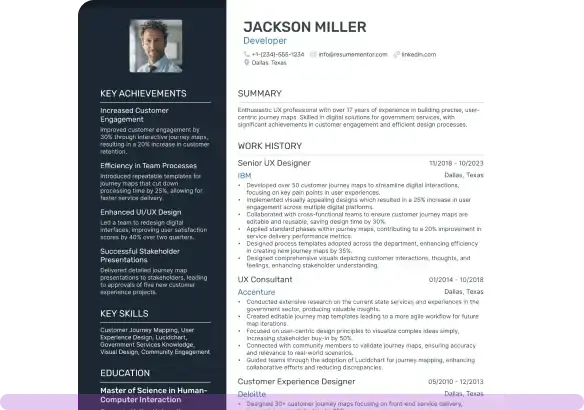Programmer Resume Examples

Mar 31, 2025
|
12 min read
Optimize your programmer resume like you optimize your code: with precision and clarity. Learn to debug common mistakes and compile a stellar CV that’ll function just right in the eyes of hiring managers. Stand out effortlessly.
Rated by 348 people
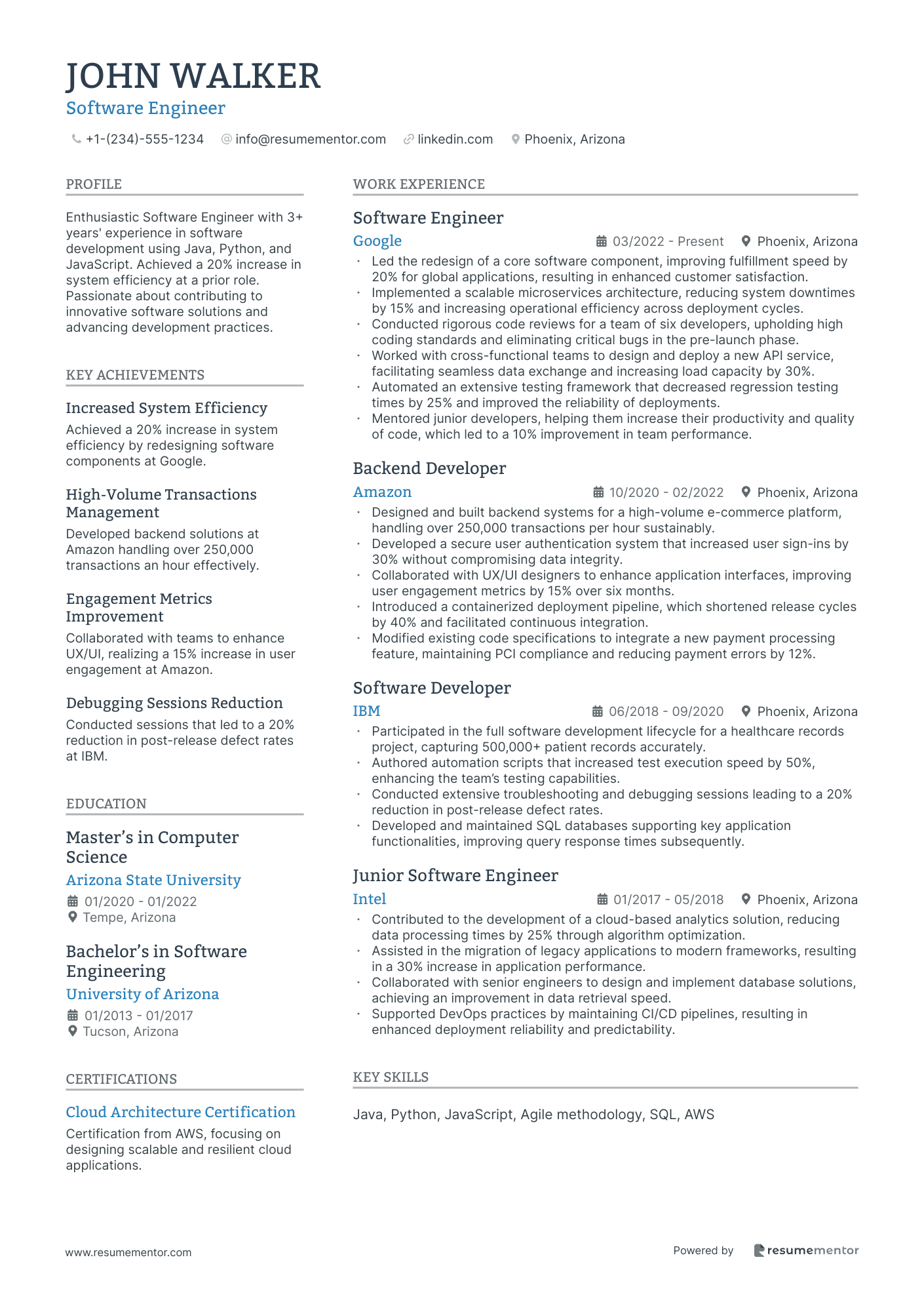
Software Engineer
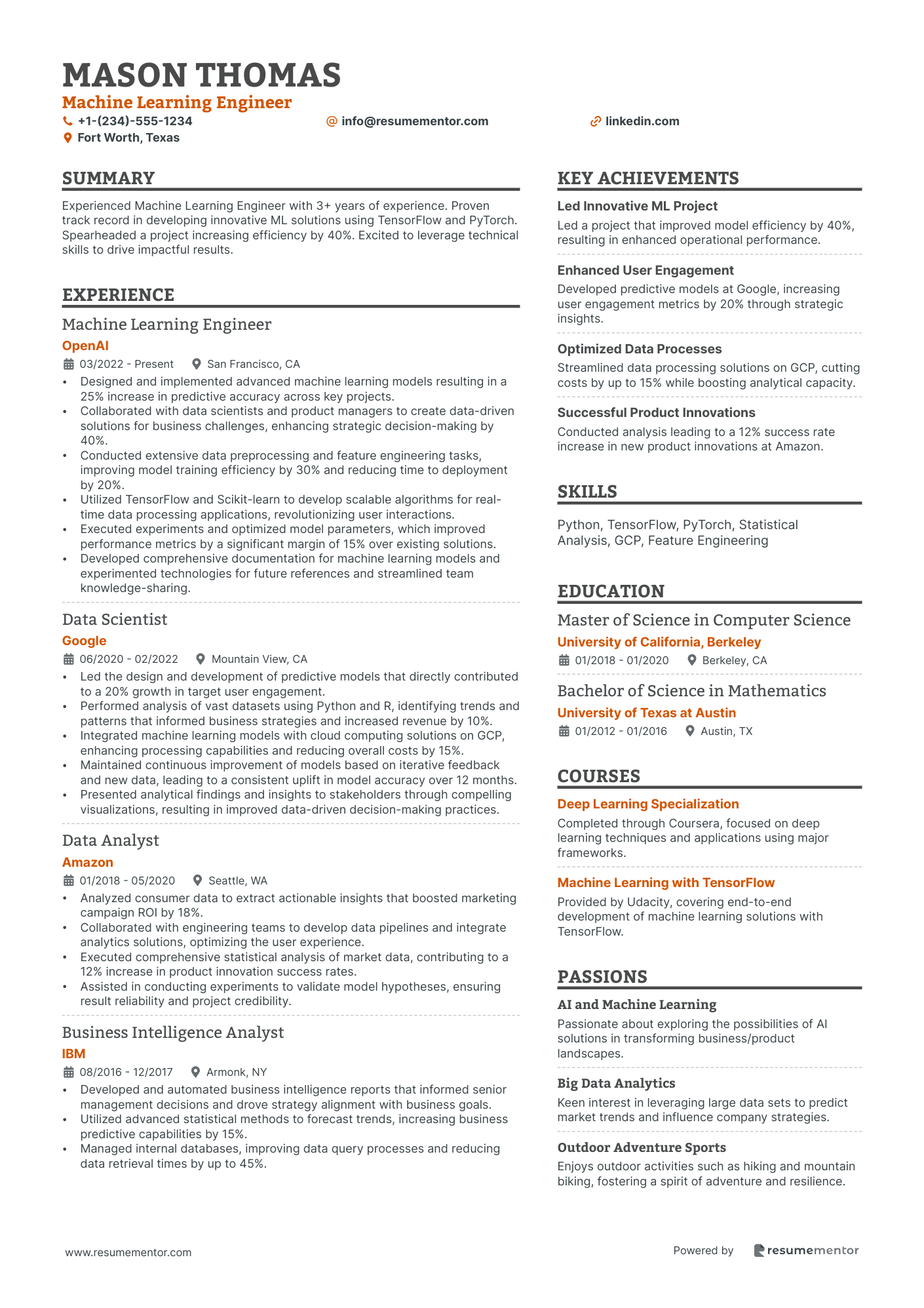
Machine Learning Engineer
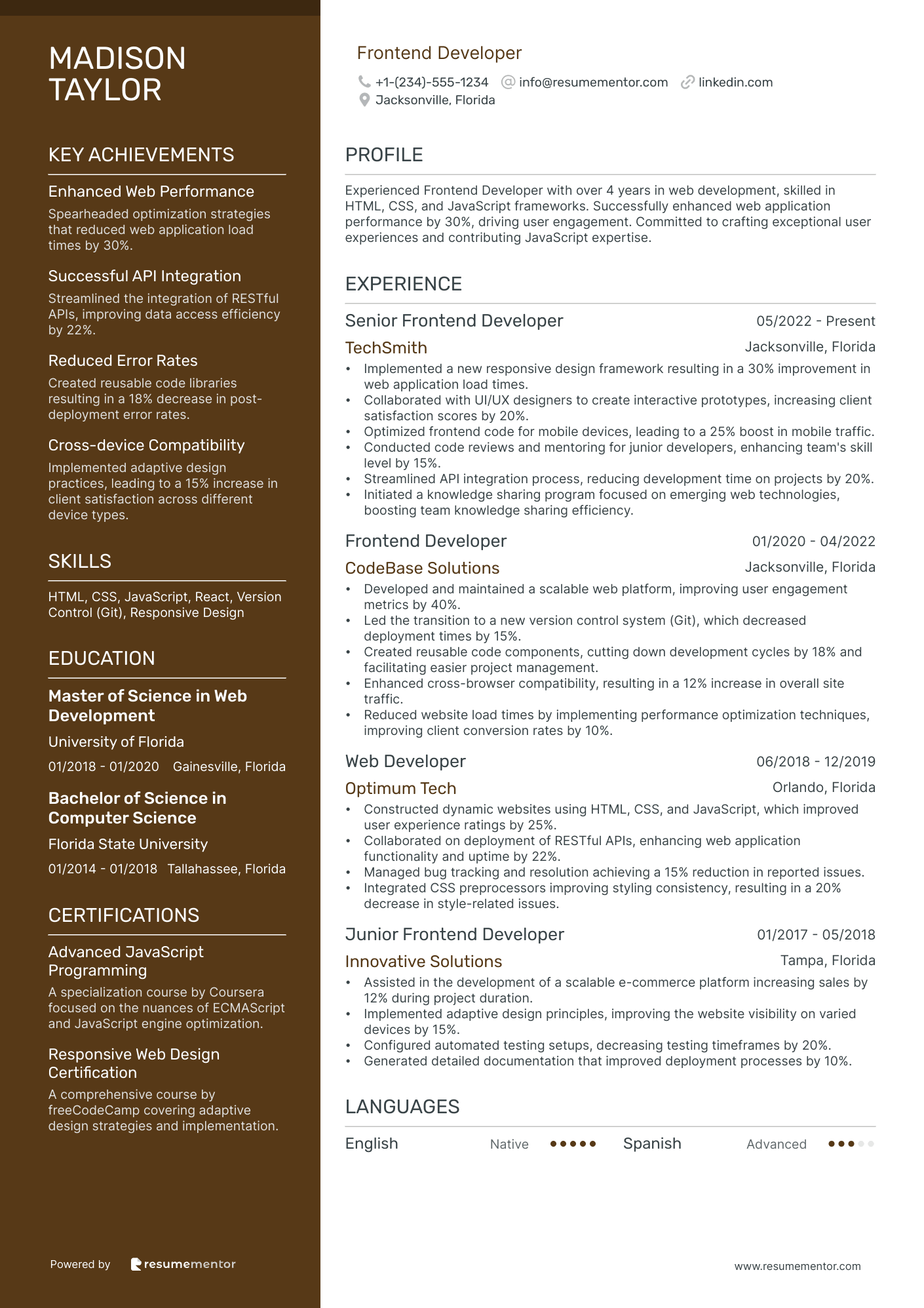
Frontend Developer
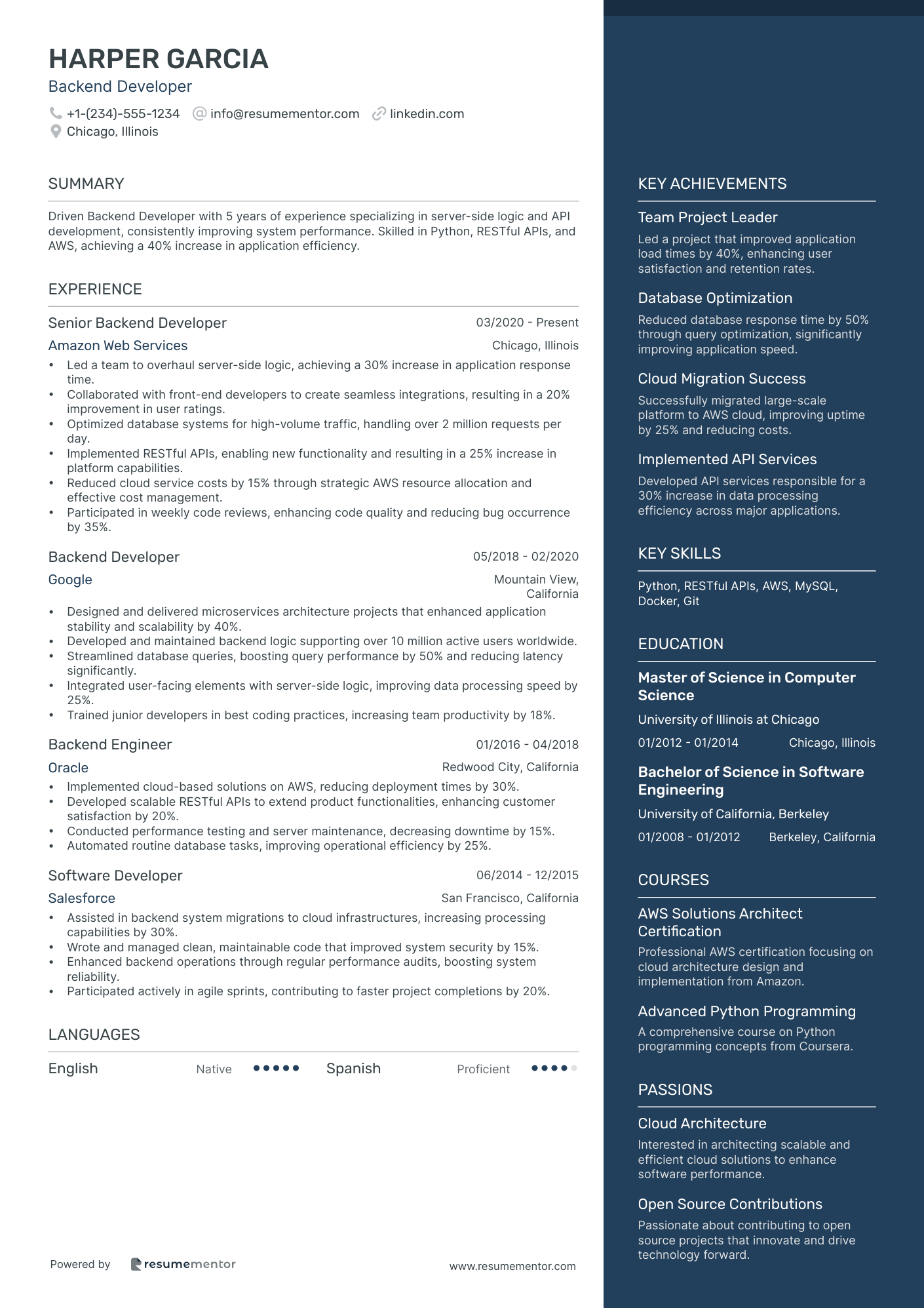
Backend Developer
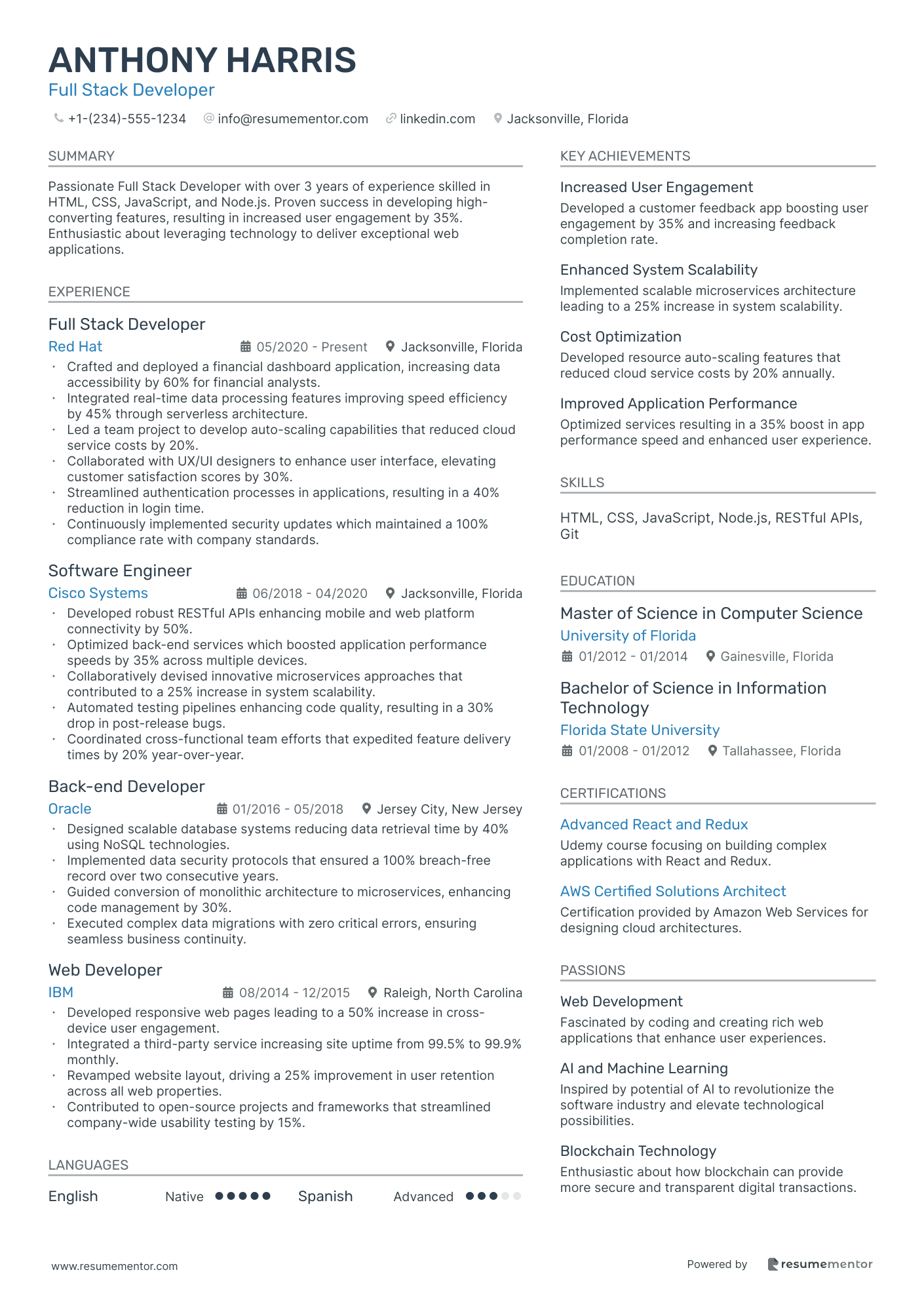
Full Stack Developer
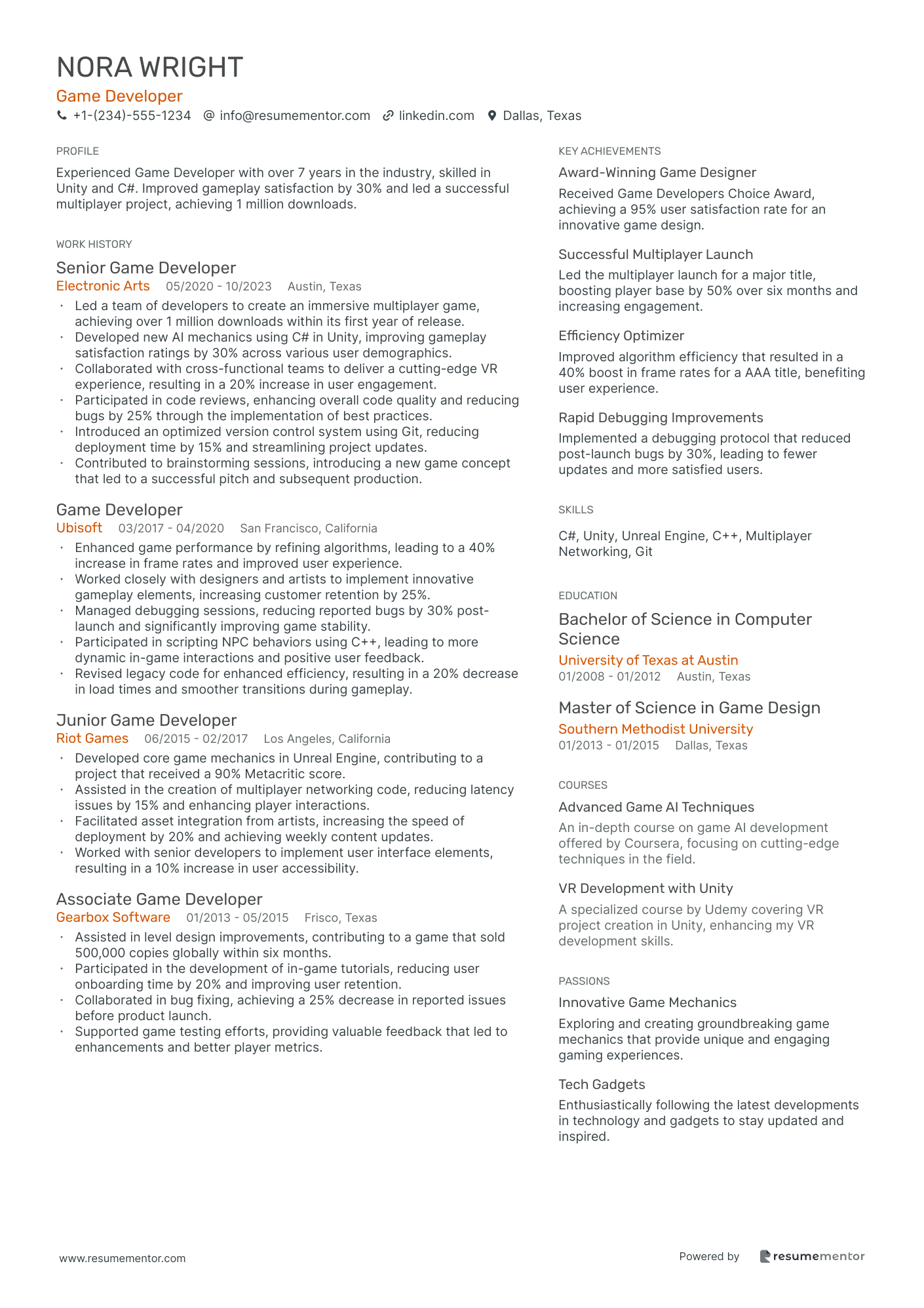
Game Developer
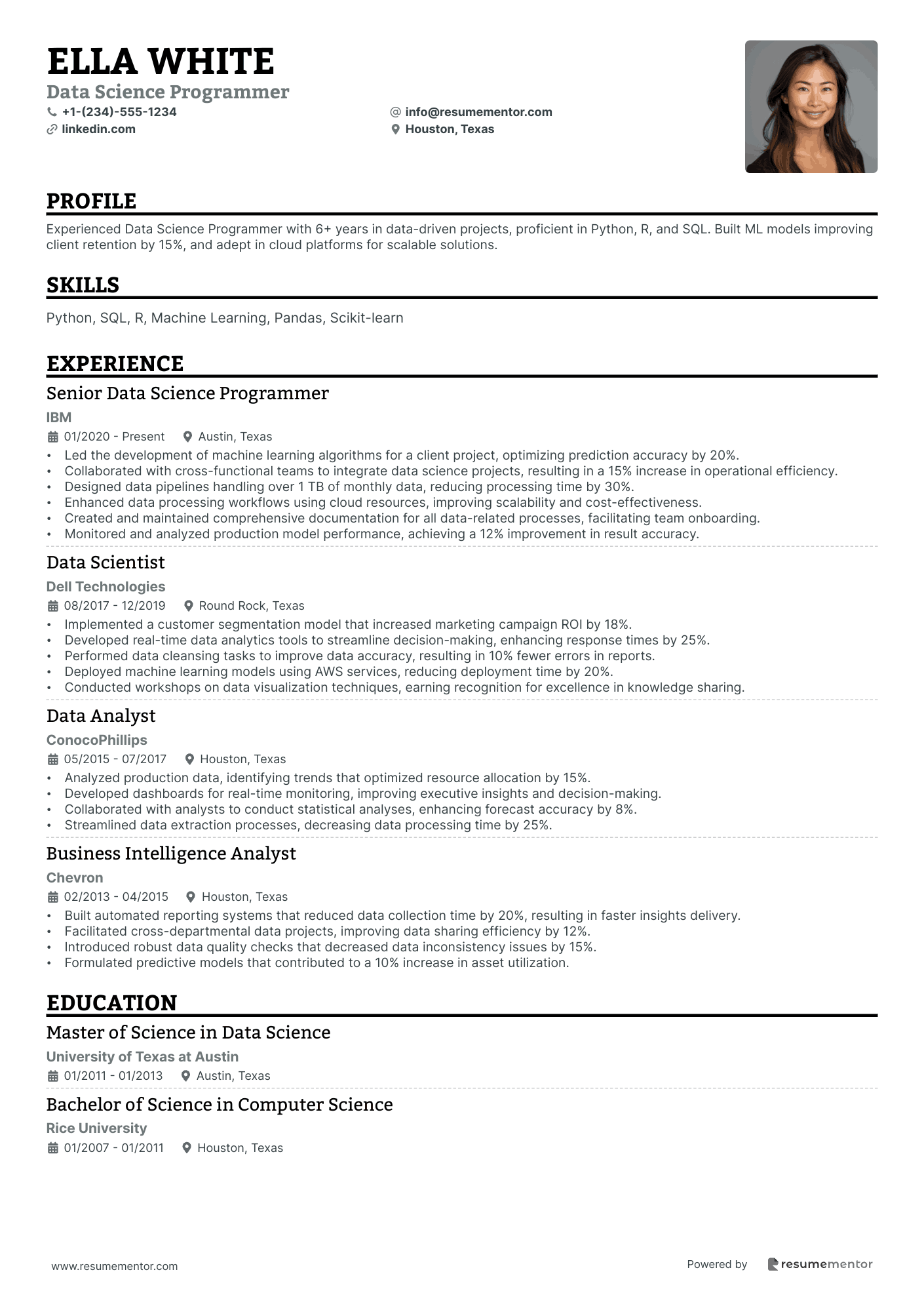
Data Science Programmer
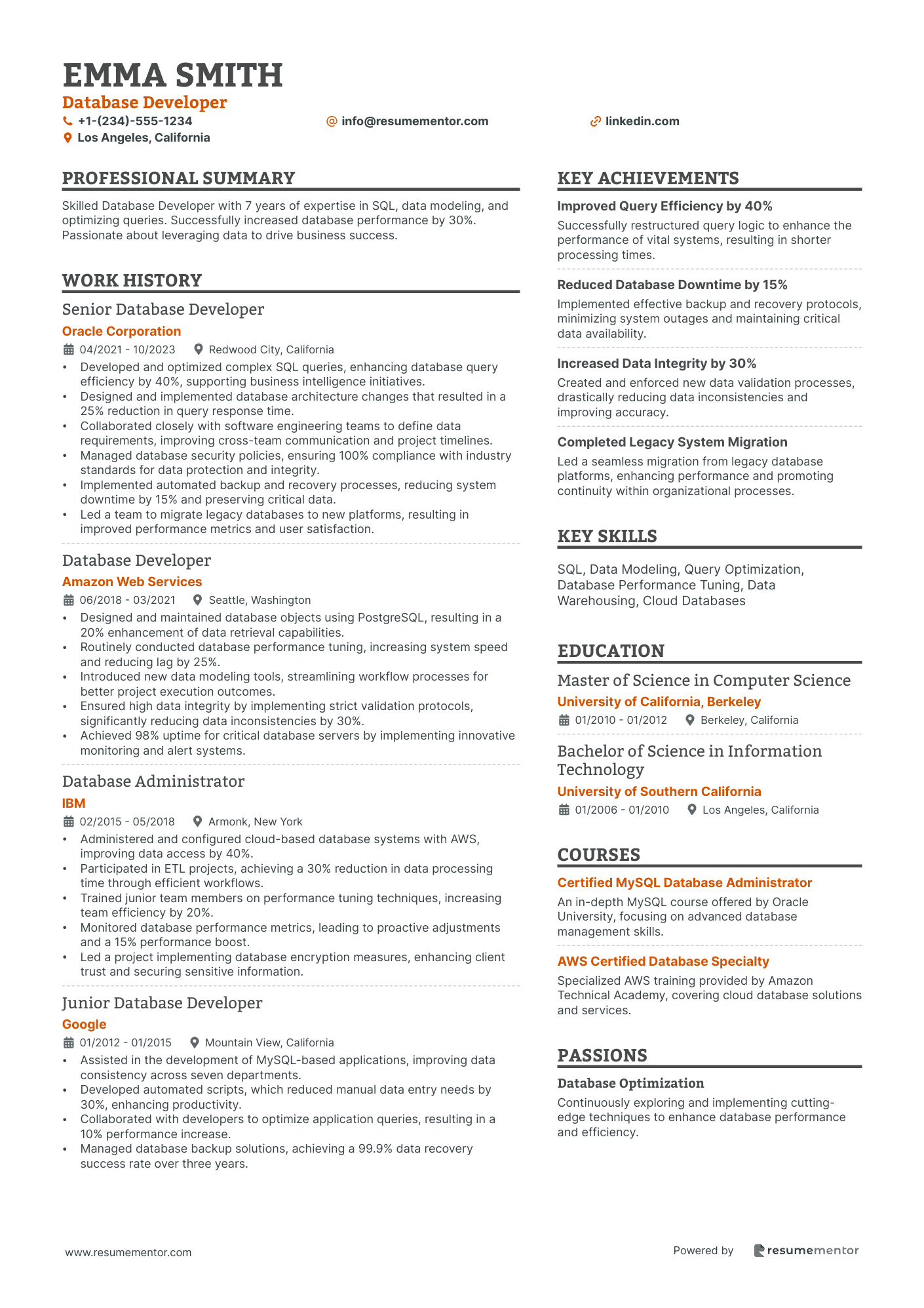
Database Developer
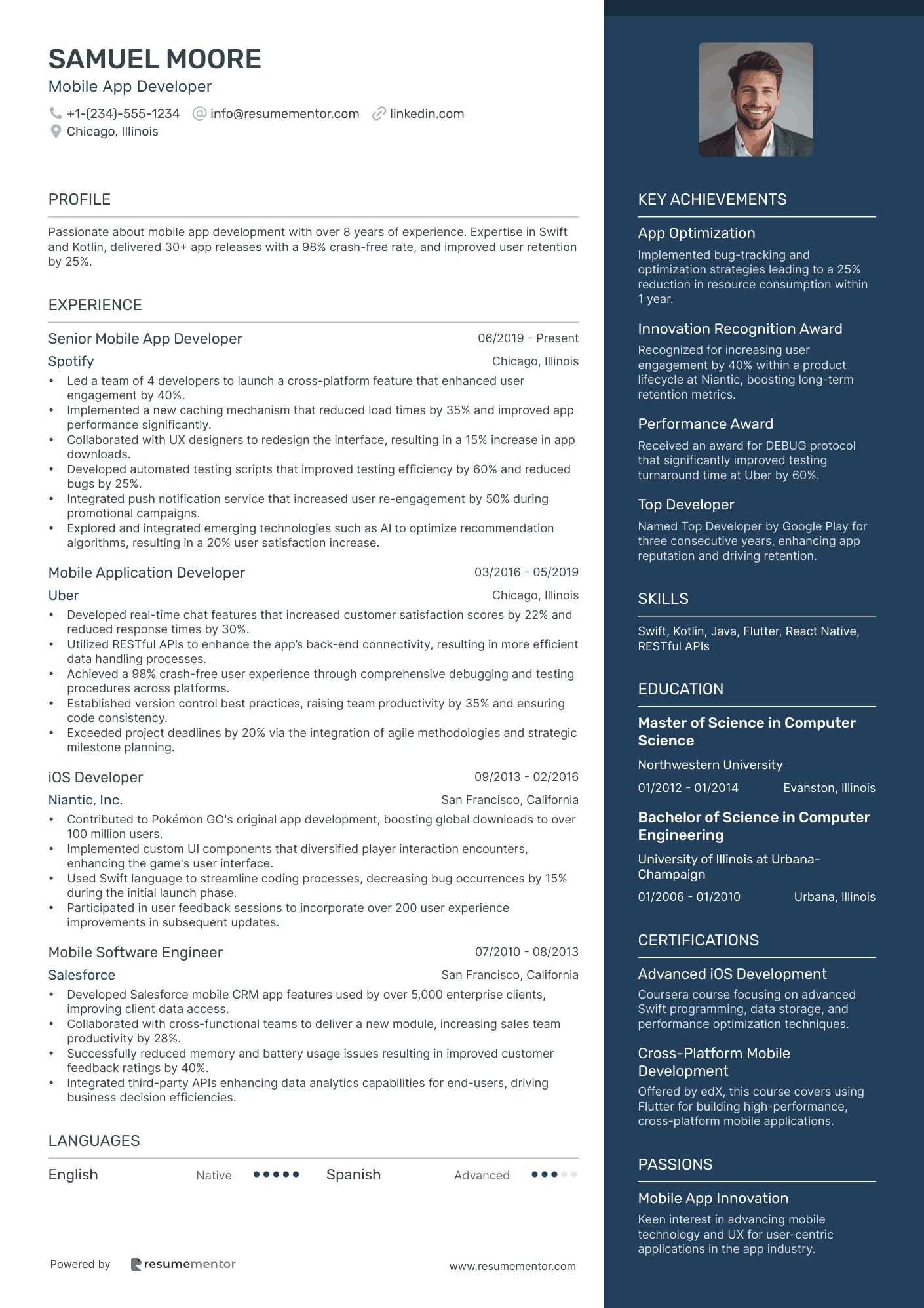
Mobile App Developer
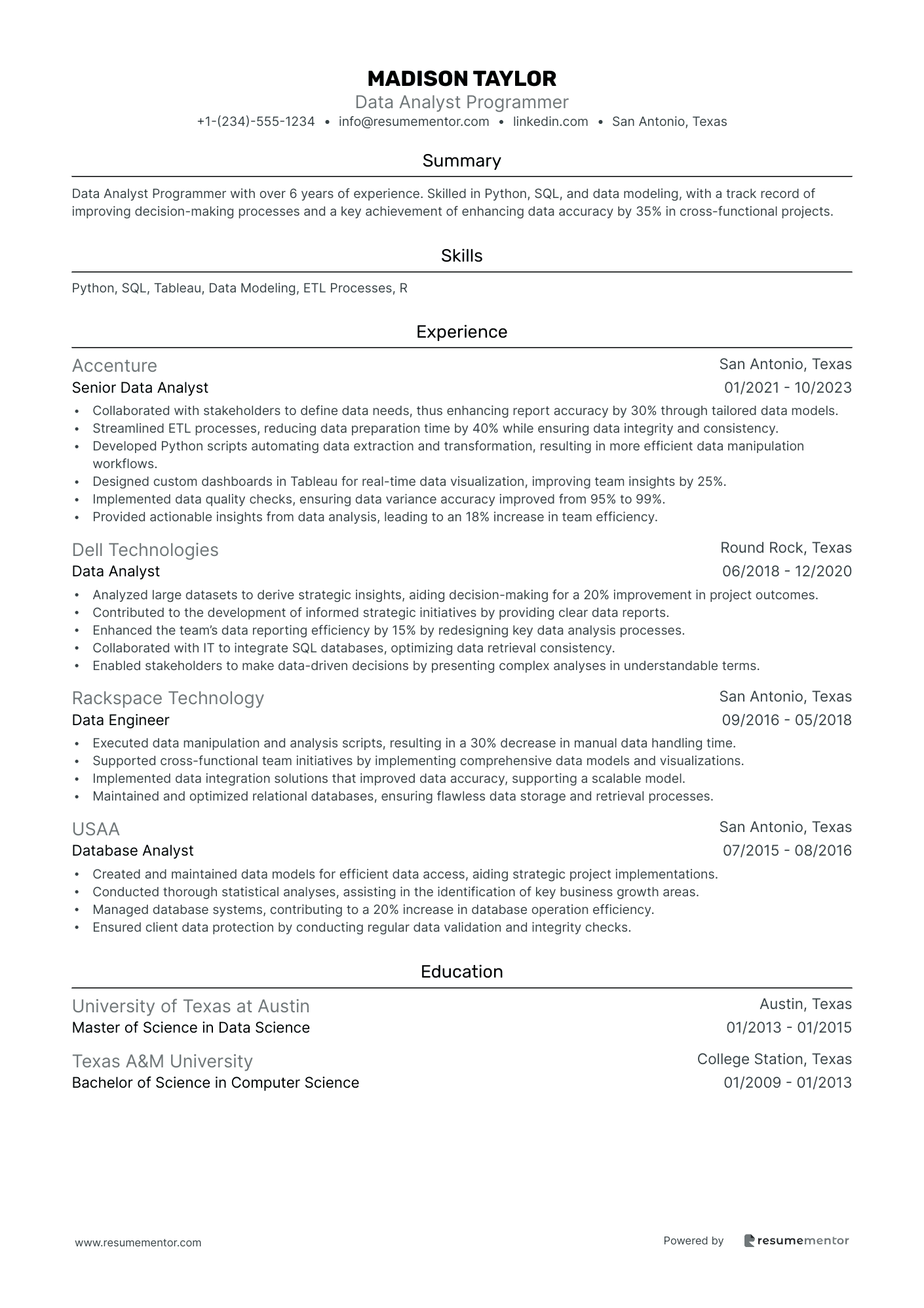
Data Analyst Programmer

Software Engineer resume sample
- •Led the redesign of a core software component, improving fulfillment speed by 20% for global applications, resulting in enhanced customer satisfaction.
- •Implemented a scalable microservices architecture, reducing system downtimes by 15% and increasing operational efficiency across deployment cycles.
- •Conducted rigorous code reviews for a team of six developers, upholding high coding standards and eliminating critical bugs in the pre-launch phase.
- •Worked with cross-functional teams to design and deploy a new API service, facilitating seamless data exchange and increasing load capacity by 30%.
- •Automated an extensive testing framework that decreased regression testing times by 25% and improved the reliability of deployments.
- •Mentored junior developers, helping them increase their productivity and quality of code, which led to a 10% improvement in team performance.
- •Designed and built backend systems for a high-volume e-commerce platform, handling over 250,000 transactions per hour sustainably.
- •Developed a secure user authentication system that increased user sign-ins by 30% without compromising data integrity.
- •Collaborated with UX/UI designers to enhance application interfaces, improving user engagement metrics by 15% over six months.
- •Introduced a containerized deployment pipeline, which shortened release cycles by 40% and facilitated continuous integration.
- •Modified existing code specifications to integrate a new payment processing feature, maintaining PCI compliance and reducing payment errors by 12%.
- •Participated in the full software development lifecycle for a healthcare records project, capturing 500,000+ patient records accurately.
- •Authored automation scripts that increased test execution speed by 50%, enhancing the team’s testing capabilities.
- •Conducted extensive troubleshooting and debugging sessions leading to a 20% reduction in post-release defect rates.
- •Developed and maintained SQL databases supporting key application functionalities, improving query response times subsequently.
- •Contributed to the development of a cloud-based analytics solution, reducing data processing times by 25% through algorithm optimization.
- •Assisted in the migration of legacy applications to modern frameworks, resulting in a 30% increase in application performance.
- •Collaborated with senior engineers to design and implement database solutions, achieving an improvement in data retrieval speed.
- •Supported DevOps practices by maintaining CI/CD pipelines, resulting in enhanced deployment reliability and predictability.
Machine Learning Engineer resume sample
- •Designed and implemented advanced machine learning models resulting in a 25% increase in predictive accuracy across key projects.
- •Collaborated with data scientists and product managers to create data-driven solutions for business challenges, enhancing strategic decision-making by 40%.
- •Conducted extensive data preprocessing and feature engineering tasks, improving model training efficiency by 30% and reducing time to deployment by 20%.
- •Utilized TensorFlow and Scikit-learn to develop scalable algorithms for real-time data processing applications, revolutionizing user interactions.
- •Executed experiments and optimized model parameters, which improved performance metrics by a significant margin of 15% over existing solutions.
- •Developed comprehensive documentation for machine learning models and experimented technologies for future references and streamlined team knowledge-sharing.
- •Led the design and development of predictive models that directly contributed to a 20% growth in target user engagement.
- •Performed analysis of vast datasets using Python and R, identifying trends and patterns that informed business strategies and increased revenue by 10%.
- •Integrated machine learning models with cloud computing solutions on GCP, enhancing processing capabilities and reducing overall costs by 15%.
- •Maintained continuous improvement of models based on iterative feedback and new data, leading to a consistent uplift in model accuracy over 12 months.
- •Presented analytical findings and insights to stakeholders through compelling visualizations, resulting in improved data-driven decision-making practices.
- •Analyzed consumer data to extract actionable insights that boosted marketing campaign ROI by 18%.
- •Collaborated with engineering teams to develop data pipelines and integrate analytics solutions, optimizing the user experience.
- •Executed comprehensive statistical analysis of market data, contributing to a 12% increase in product innovation success rates.
- •Assisted in conducting experiments to validate model hypotheses, ensuring result reliability and project credibility.
- •Developed and automated business intelligence reports that informed senior management decisions and drove strategy alignment with business goals.
- •Utilized advanced statistical methods to forecast trends, increasing business predictive capabilities by 15%.
- •Managed internal databases, improving data query processes and reducing data retrieval times by up to 45%.
Frontend Developer resume sample
- •Implemented a new responsive design framework resulting in a 30% improvement in web application load times.
- •Collaborated with UI/UX designers to create interactive prototypes, increasing client satisfaction scores by 20%.
- •Optimized frontend code for mobile devices, leading to a 25% boost in mobile traffic.
- •Conducted code reviews and mentoring for junior developers, enhancing team's skill level by 15%.
- •Streamlined API integration process, reducing development time on projects by 20%.
- •Initiated a knowledge sharing program focused on emerging web technologies, boosting team knowledge sharing efficiency.
- •Developed and maintained a scalable web platform, improving user engagement metrics by 40%.
- •Led the transition to a new version control system (Git), which decreased deployment times by 15%.
- •Created reusable code components, cutting down development cycles by 18% and facilitating easier project management.
- •Enhanced cross-browser compatibility, resulting in a 12% increase in overall site traffic.
- •Reduced website load times by implementing performance optimization techniques, improving client conversion rates by 10%.
- •Constructed dynamic websites using HTML, CSS, and JavaScript, which improved user experience ratings by 25%.
- •Collaborated on deployment of RESTful APIs, enhancing web application functionality and uptime by 22%.
- •Managed bug tracking and resolution achieving a 15% reduction in reported issues.
- •Integrated CSS preprocessors improving styling consistency, resulting in a 20% decrease in style-related issues.
- •Assisted in the development of a scalable e-commerce platform increasing sales by 12% during project duration.
- •Implemented adaptive design principles, improving the website visibility on varied devices by 15%.
- •Configured automated testing setups, decreasing testing timeframes by 20%.
- •Generated detailed documentation that improved deployment processes by 10%.
Backend Developer resume sample
- •Led a team to overhaul server-side logic, achieving a 30% increase in application response time.
- •Collaborated with front-end developers to create seamless integrations, resulting in a 20% improvement in user ratings.
- •Optimized database systems for high-volume traffic, handling over 2 million requests per day.
- •Implemented RESTful APIs, enabling new functionality and resulting in a 25% increase in platform capabilities.
- •Reduced cloud service costs by 15% through strategic AWS resource allocation and effective cost management.
- •Participated in weekly code reviews, enhancing code quality and reducing bug occurrence by 35%.
- •Designed and delivered microservices architecture projects that enhanced application stability and scalability by 40%.
- •Developed and maintained backend logic supporting over 10 million active users worldwide.
- •Streamlined database queries, boosting query performance by 50% and reducing latency significantly.
- •Integrated user-facing elements with server-side logic, improving data processing speed by 25%.
- •Trained junior developers in best coding practices, increasing team productivity by 18%.
- •Implemented cloud-based solutions on AWS, reducing deployment times by 30%.
- •Developed scalable RESTful APIs to extend product functionalities, enhancing customer satisfaction by 20%.
- •Conducted performance testing and server maintenance, decreasing downtime by 15%.
- •Automated routine database tasks, improving operational efficiency by 25%.
- •Assisted in backend system migrations to cloud infrastructures, increasing processing capabilities by 30%.
- •Wrote and managed clean, maintainable code that improved system security by 15%.
- •Enhanced backend operations through regular performance audits, boosting system reliability.
- •Participated actively in agile sprints, contributing to faster project completions by 20%.
Full Stack Developer resume sample
- •Crafted and deployed a financial dashboard application, increasing data accessibility by 60% for financial analysts.
- •Integrated real-time data processing features improving speed efficiency by 45% through serverless architecture.
- •Led a team project to develop auto-scaling capabilities that reduced cloud service costs by 20%.
- •Collaborated with UX/UI designers to enhance user interface, elevating customer satisfaction scores by 30%.
- •Streamlined authentication processes in applications, resulting in a 40% reduction in login time.
- •Continuously implemented security updates which maintained a 100% compliance rate with company standards.
- •Developed robust RESTful APIs enhancing mobile and web platform connectivity by 50%.
- •Optimized back-end services which boosted application performance speeds by 35% across multiple devices.
- •Collaboratively devised innovative microservices approaches that contributed to a 25% increase in system scalability.
- •Automated testing pipelines enhancing code quality, resulting in a 30% drop in post-release bugs.
- •Coordinated cross-functional team efforts that expedited feature delivery times by 20% year-over-year.
- •Designed scalable database systems reducing data retrieval time by 40% using NoSQL technologies.
- •Implemented data security protocols that ensured a 100% breach-free record over two consecutive years.
- •Guided conversion of monolithic architecture to microservices, enhancing code management by 30%.
- •Executed complex data migrations with zero critical errors, ensuring seamless business continuity.
- •Developed responsive web pages leading to a 50% increase in cross-device user engagement.
- •Integrated a third-party service increasing site uptime from 99.5% to 99.9% monthly.
- •Revamped website layout, driving a 25% improvement in user retention across all web properties.
- •Contributed to open-source projects and frameworks that streamlined company-wide usability testing by 15%.
Game Developer resume sample
- •Led a team of developers to create an immersive multiplayer game, achieving over 1 million downloads within its first year of release.
- •Developed new AI mechanics using C# in Unity, improving gameplay satisfaction ratings by 30% across various user demographics.
- •Collaborated with cross-functional teams to deliver a cutting-edge VR experience, resulting in a 20% increase in user engagement.
- •Participated in code reviews, enhancing overall code quality and reducing bugs by 25% through the implementation of best practices.
- •Introduced an optimized version control system using Git, reducing deployment time by 15% and streamlining project updates.
- •Contributed to brainstorming sessions, introducing a new game concept that led to a successful pitch and subsequent production.
- •Enhanced game performance by refining algorithms, leading to a 40% increase in frame rates and improved user experience.
- •Worked closely with designers and artists to implement innovative gameplay elements, increasing customer retention by 25%.
- •Managed debugging sessions, reducing reported bugs by 30% post-launch and significantly improving game stability.
- •Participated in scripting NPC behaviors using C++, leading to more dynamic in-game interactions and positive user feedback.
- •Revised legacy code for enhanced efficiency, resulting in a 20% decrease in load times and smoother transitions during gameplay.
- •Developed core game mechanics in Unreal Engine, contributing to a project that received a 90% Metacritic score.
- •Assisted in the creation of multiplayer networking code, reducing latency issues by 15% and enhancing player interactions.
- •Facilitated asset integration from artists, increasing the speed of deployment by 20% and achieving weekly content updates.
- •Worked with senior developers to implement user interface elements, resulting in a 10% increase in user accessibility.
- •Assisted in level design improvements, contributing to a game that sold 500,000 copies globally within six months.
- •Participated in the development of in-game tutorials, reducing user onboarding time by 20% and improving user retention.
- •Collaborated in bug fixing, achieving a 25% decrease in reported issues before product launch.
- •Supported game testing efforts, providing valuable feedback that led to enhancements and better player metrics.
Data Science Programmer resume sample
- •Led the development of machine learning algorithms for a client project, optimizing prediction accuracy by 20%.
- •Collaborated with cross-functional teams to integrate data science projects, resulting in a 15% increase in operational efficiency.
- •Designed data pipelines handling over 1 TB of monthly data, reducing processing time by 30%.
- •Enhanced data processing workflows using cloud resources, improving scalability and cost-effectiveness.
- •Created and maintained comprehensive documentation for all data-related processes, facilitating team onboarding.
- •Monitored and analyzed production model performance, achieving a 12% improvement in result accuracy.
- •Implemented a customer segmentation model that increased marketing campaign ROI by 18%.
- •Developed real-time data analytics tools to streamline decision-making, enhancing response times by 25%.
- •Performed data cleansing tasks to improve data accuracy, resulting in 10% fewer errors in reports.
- •Deployed machine learning models using AWS services, reducing deployment time by 20%.
- •Conducted workshops on data visualization techniques, earning recognition for excellence in knowledge sharing.
- •Analyzed production data, identifying trends that optimized resource allocation by 15%.
- •Developed dashboards for real-time monitoring, improving executive insights and decision-making.
- •Collaborated with analysts to conduct statistical analyses, enhancing forecast accuracy by 8%.
- •Streamlined data extraction processes, decreasing data processing time by 25%.
- •Built automated reporting systems that reduced data collection time by 20%, resulting in faster insights delivery.
- •Facilitated cross-departmental data projects, improving data sharing efficiency by 12%.
- •Introduced robust data quality checks that decreased data inconsistency issues by 15%.
- •Formulated predictive models that contributed to a 10% increase in asset utilization.
Database Developer resume sample
- •Developed and optimized complex SQL queries, enhancing database query efficiency by 40%, supporting business intelligence initiatives.
- •Designed and implemented database architecture changes that resulted in a 25% reduction in query response time.
- •Collaborated closely with software engineering teams to define data requirements, improving cross-team communication and project timelines.
- •Managed database security policies, ensuring 100% compliance with industry standards for data protection and integrity.
- •Implemented automated backup and recovery processes, reducing system downtime by 15% and preserving critical data.
- •Led a team to migrate legacy databases to new platforms, resulting in improved performance metrics and user satisfaction.
- •Designed and maintained database objects using PostgreSQL, resulting in a 20% enhancement of data retrieval capabilities.
- •Routinely conducted database performance tuning, increasing system speed and reducing lag by 25%.
- •Introduced new data modeling tools, streamlining workflow processes for better project execution outcomes.
- •Ensured high data integrity by implementing strict validation protocols, significantly reducing data inconsistencies by 30%.
- •Achieved 98% uptime for critical database servers by implementing innovative monitoring and alert systems.
- •Administered and configured cloud-based database systems with AWS, improving data access by 40%.
- •Participated in ETL projects, achieving a 30% reduction in data processing time through efficient workflows.
- •Trained junior team members on performance tuning techniques, increasing team efficiency by 20%.
- •Monitored database performance metrics, leading to proactive adjustments and a 15% performance boost.
- •Led a project implementing database encryption measures, enhancing client trust and securing sensitive information.
- •Assisted in the development of MySQL-based applications, improving data consistency across seven departments.
- •Developed automated scripts, which reduced manual data entry needs by 30%, enhancing productivity.
- •Collaborated with developers to optimize application queries, resulting in a 10% performance increase.
- •Managed database backup solutions, achieving a 99.9% data recovery success rate over three years.
Mobile App Developer resume sample
- •Led a team of 4 developers to launch a cross-platform feature that enhanced user engagement by 40%.
- •Implemented a new caching mechanism that reduced load times by 35% and improved app performance significantly.
- •Collaborated with UX designers to redesign the interface, resulting in a 15% increase in app downloads.
- •Developed automated testing scripts that improved testing efficiency by 60% and reduced bugs by 25%.
- •Integrated push notification service that increased user re-engagement by 50% during promotional campaigns.
- •Explored and integrated emerging technologies such as AI to optimize recommendation algorithms, resulting in a 20% user satisfaction increase.
- •Developed real-time chat features that increased customer satisfaction scores by 22% and reduced response times by 30%.
- •Utilized RESTful APIs to enhance the app’s back-end connectivity, resulting in more efficient data handling processes.
- •Achieved a 98% crash-free user experience through comprehensive debugging and testing procedures across platforms.
- •Established version control best practices, raising team productivity by 35% and ensuring code consistency.
- •Exceeded project deadlines by 20% via the integration of agile methodologies and strategic milestone planning.
- •Contributed to Pokémon GO's original app development, boosting global downloads to over 100 million users.
- •Implemented custom UI components that diversified player interaction encounters, enhancing the game's user interface.
- •Used Swift language to streamline coding processes, decreasing bug occurrences by 15% during the initial launch phase.
- •Participated in user feedback sessions to incorporate over 200 user experience improvements in subsequent updates.
- •Developed Salesforce mobile CRM app features used by over 5,000 enterprise clients, improving client data access.
- •Collaborated with cross-functional teams to deliver a new module, increasing sales team productivity by 28%.
- •Successfully reduced memory and battery usage issues resulting in improved customer feedback ratings by 40%.
- •Integrated third-party APIs enhancing data analytics capabilities for end-users, driving business decision efficiencies.
Data Analyst Programmer resume sample
- •Collaborated with stakeholders to define data needs, thus enhancing report accuracy by 30% through tailored data models.
- •Streamlined ETL processes, reducing data preparation time by 40% while ensuring data integrity and consistency.
- •Developed Python scripts automating data extraction and transformation, resulting in more efficient data manipulation workflows.
- •Designed custom dashboards in Tableau for real-time data visualization, improving team insights by 25%.
- •Implemented data quality checks, ensuring data variance accuracy improved from 95% to 99%.
- •Provided actionable insights from data analysis, leading to an 18% increase in team efficiency.
- •Analyzed large datasets to derive strategic insights, aiding decision-making for a 20% improvement in project outcomes.
- •Contributed to the development of informed strategic initiatives by providing clear data reports.
- •Enhanced the team’s data reporting efficiency by 15% by redesigning key data analysis processes.
- •Collaborated with IT to integrate SQL databases, optimizing data retrieval consistency.
- •Enabled stakeholders to make data-driven decisions by presenting complex analyses in understandable terms.
- •Executed data manipulation and analysis scripts, resulting in a 30% decrease in manual data handling time.
- •Supported cross-functional team initiatives by implementing comprehensive data models and visualizations.
- •Implemented data integration solutions that improved data accuracy, supporting a scalable model.
- •Maintained and optimized relational databases, ensuring flawless data storage and retrieval processes.
- •Created and maintained data models for efficient data access, aiding strategic project implementations.
- •Conducted thorough statistical analyses, assisting in the identification of key business growth areas.
- •Managed database systems, contributing to a 20% increase in database operation efficiency.
- •Ensured client data protection by conducting regular data validation and integrity checks.
Crafting a programming resume can feel like debugging a complex code—challenging but rewarding when done right. Just like how you're adept at weaving intricate algorithms, organizing your resume can showcase your problem-solving skills. Yet, translating that technical expertise into a compelling narrative may not come naturally. It's crucial to make your strengths clear to potential employers who might not speak your technical language fluently.
That's why a solid, well-designed resume template is essential for organizing your skills, projects, and accomplishments effectively. Templates offer structure, ensuring your technical experience aligns perfectly with job requirements. This alignment becomes the bridge between you and hiring managers, who look for a clear story of your coding journey and problem-solving abilities.
With a good template guiding you, not only does your resume become more readable and professional, but it also emphasizes the qualities that make you a standout candidate. By seamlessly blending these elements, your resume can transform into a powerful tool in your job search arsenal.
Ready to dive in? Let's explore how presenting your programming expertise effectively can set you apart in the competitive tech landscape, turning your resume into an invitation for interviews instead of overlooking glances.
Key Takeaways
- Creating a well-structured programmer resume involves using a template to align your skills and experiences with job requirements, which helps communicate your technical journey effectively to hiring managers.
- Key components of a resume include a professional summary, technical skills section, work experience, education, projects, and extra sections like certifications to showcase your strengths.
- Choosing the right format, such as reverse chronological order, and using modern fonts and consistent formatting ensure your resume is visually appealing and easy to read.
- Quantifiable achievements and action-oriented language in your experience section demonstrate your impact and align with job descriptions, showcasing your problem-solving abilities.
- A resume should highlight both hard and soft skills, with hard skills detailing technical capabilities and soft skills illustrating collaboration and problem-solving strengths, enhancing your appeal to employers.
What to focus on when writing your programmer resume
Your programmer resume should highlight your coding skills and tech experience to catch a recruiter’s eye by clearly conveying your problem-solving abilities and software development expertise. This guide will delve into how to craft each vital section while maintaining an ATS-friendly format.
How to structure your programmer resume
- Contact Information: Start with your full name, phone number, email, and LinkedIn profile at the top to ensure recruiters can easily get in touch. Make sure the information is up-to-date and professional, as it's often the first impression an employer will have of you.
- Professional Summary: Craft a brief overview of your programming background and key achievements—mentioning specific languages and technologies like Python or cloud platforms that set you apart. This should succinctly capture who you are as a professional and hint at what you're capable of, setting the tone for the rest of the resume.
- Technical Skills: Follow with a list of programming languages, frameworks, databases, and tools you excel in, focusing on those most relevant to your field, such as AWS, React, or SQL. Organize this list to highlight your strengths, and tailor it to match the job description you're targeting to show you're a strong fit for the role.
- Work Experience: Share your previous roles with company names, positions, and employment dates. Use bullet points to demonstrate your accomplishments—like boosting application efficiency or building scalable systems—linking them back to your technical skills. Quantify your achievements when possible to provide concrete evidence of your impact.
- Education: Include your degree, school name, and graduation date, adding relevant coursework or projects that deepen your expertise in software engineering. This emphasizes your formal training and lays a foundation for understanding your technical capabilities.
- Projects: Expand on any freelance work, open-source contributions, or coding competitions—highlighting the technologies you used and the successful outcomes, which reinforce the experiences and skills you've listed. Projects show your initiative and passion, further rounding out your professional profile.
To further enrich your programmer resume, consider adding sections for certifications, volunteer work, or publications. Achievements like an AWS Certified Developer title or writing for tech blogs can significantly enhance your profile. Next, we'll cover each section more in-depth and discuss how to format your resume for the best results.
Which resume format to choose
Creating a standout programmer resume involves a strategic approach to formatting and style. Start with a reverse chronological format, highly favored in the tech industry, as it highlights your most recent projects and roles. This approach makes it easy for employers to quickly grasp your current experience and the tools you’re proficient with.
Choose fonts like Rubik, Lato, or Montserrat to give your resume a modern edge. These fonts are not only aesthetically pleasing but also enhance readability, which is key when conveying technical skills and detailed project descriptions.
Always save your resume as a PDF to maintain its format across all devices. This consistent appearance ensures that hiring managers see your resume exactly as you intended, whether they’re reviewing it on a computer or a smartphone.
Use one-inch margins to strike a balance between text and white space. This spacing not only keeps your resume looking clean but also makes it easier for employers to focus on the important details, like your coding languages and software experience.
When these elements work together, they create a resume that effectively communicates your skills and accomplishments. This integrated approach ensures that your expertise stands out to potential employers in the tech industry.
How to write a quantifiable resume experience section
Your programmer resume experience section plays a crucial role. Employers are eager to see results-driven accomplishments, so it’s important to emphasize your technical skills and the impact you’ve had in past roles. Start by structuring each entry with a clear job title, company name, date range, and location. When listing your experience, prioritize recent roles in reverse chronological order, going back about 10 years unless an older role is particularly relevant. To capture employers’ attention, tailor your resume by incorporating keywords and phrases from the job ad. Choosing action verbs like "developed," "optimized," or "implemented" helps to convey your achievements in a powerful way. Make sure each accomplishment is quantifiable to illustrate your contributions to business success effectively.
- •Boosted system efficiency by 25% by optimizing backend processes.
- •Cut third-party API access time by 60% with a new strategy.
- •Created features increasing user engagement by 40%.
- •Mentored junior developers, raising team productivity by 30%.
This experience section stands out by cohesively linking your technical abilities with tangible results. By ensuring your achievements are quantifiable, you clearly demonstrate your capacity to make a significant impact. The action-oriented language makes your experience come alive, showing that you’re proactive and focused on achieving results. By weaving in specific percentages and figures, you establish credibility and capture attention. Incorporating keywords from job ads ensures your resume aligns with what employers are seeking, enhancing your fit for the role. Mentioning mentorship success adds depth to your leadership skills, while the concise structure ensures the information is scannable and informative, making it easy for employers to assess your suitability.
Problem-Solving Focused resume experience section
A programmer-focused resume experience section should effectively highlight your ability to tackle complex challenges and deliver practical solutions. Begin by showcasing a project or work type that underscores your problem-solving skills. Clearly explain your responsibilities, outlining the steps you took to diagnose and address issues. Emphasize the tools or methods you used and the tangible results, like time savings, cost reductions, or performance gains, which showcase your impact.
Use metrics or outcomes whenever possible to provide concrete proof of your successes. Describe technical challenges in a way that even non-technical hiring managers can grasp. Structure the information clearly so that employers can quickly recognize your skills. The focus should remain on how your problem-solving contributions positively impacted your projects or the organization.
Software Engineer
Tech Giants Inc.
June 2020 - Present
- Enhanced system efficiency by refactoring code, decreasing processing time by 30%.
- Implemented automated tests, reducing bugs in production by 40%.
- Collaborated with cross-functional teams to resolve critical server downtime issues.
- Developed a monitoring system that proactively alerts the team about potential system failures.
Training and Development Focused resume experience section
A programmer-focused resume experience section should clearly demonstrate your skills and achievements in training and development. Start by showcasing how you have elevated team growth and enhanced skills in programming. Use specific examples, such as the number of people you trained or notable improvements in performance, to underscore your impact. Keep your language straightforward to ensure your accomplishments are easily understood by anyone reviewing your resume.
Detail your job titles and timelines to illustrate your career progression. The bullet points should weave together your responsibilities and key achievements, like designing impactful training initiatives or mentoring junior team members. Ensure each point establishes a clear connection between your actions and their positive outcomes, emphasizing your leadership in fostering a culture of continuous learning and skill development.
Senior Developer
Tech Innovations Inc.
June 2020 - Present
- Created a coding bootcamp that boosted participants' skills by 40%
- Trained over 100 junior programmers, achieving a 90% on-time project delivery rate
- Built an online learning platform used by 500 employees to enhance technical skills
- Started mentorship programs that improved teamwork and productivity by 25%
Project-Focused resume experience section
A project-focused programmer resume experience section should clearly communicate your skills and achievements through specific projects. Begin by stating this focus, like "Project Work Experience," and for each entry, include details such as your role, the dates involved, the project title, and the organization. Using bullet points to list your main responsibilities and accomplishments helps hiring managers quickly grasp the impact of your work. This concise format guides them through your contributions with ease.
To stand out, focus on the measurable results and specific contributions you made. Rather than listing everyday tasks, highlight what you achieved and its benefits for your team or the project. Mention any tools or methods you applied and describe the impact of your solutions. By doing this, you emphasize not just what you did, but how effectively you drove success and added value.
Lead Developer
Tech Innovations Ltd.
Jan 2022 - Present
- Led a team of 5 to develop an inventory management app using Python, cutting processing time by 30%.
- Implemented agile practices that boosted productivity by 20%.
- Integrated AI tools to automate data entry, reducing manual errors by 25%.
- Worked with the design team to enhance the user interface, improving user satisfaction scores.
Technology-Focused resume experience section
A programmer-focused resume experience section should put the spotlight on your technical skills and the specific impact you've made in your roles. Start off with your most recent position and move backward, clearly laying out the employment dates and responsibilities. Through strong action verbs, describe how you used your skills to tackle challenges and enhance systems. Each bullet point should pinpoint measurable outcomes while showcasing the technologies you’ve mastered, ensuring you resonate with potential employers and effectively demonstrate your value.
It's also vital to convey the tangible difference your work brought about in each role. Share any improvements you achieved, such as streamlining processes or enhancing performance metrics, to illustrate your contributions. Explain how your initiatives contributed to the overall success of projects or teams. Use straightforward, yet impactful language to highlight the results, showcasing your ability to make a significant impact in any organization.
Software Developer
Tech Innovations Inc.
June 2021 - Present
- Led a team of 4 developers to design an internal tool that reduced reporting time by 30%.
- Developed a scalable API using Node.js, improving server response times by 50%.
- Optimized front-end performance using React, resulting in a 40% decrease in page load time.
- Collaborated with the UX team to implement a new user interface, boosting user engagement by 20%.
Write your programmer resume summary section
A programmer-focused resume summary should quickly highlight your skills and achievements to capture the attention of hiring managers. As an experienced programmer, you want this section to emphasize what sets you apart from others, showcasing your unique strengths in just a few lines. Here's a summary example for a programmer that achieves this goal:
This summary stands out because it's clear and concise, mentioning both years of experience and specific programming skills. It seamlessly transitions into highlighting leadership abilities and success in improving user experiences. Words like "experienced" and "proven track record" lend authority and confidence, making the summary compelling. When describing yourself, specificity is key; focus on achievements and skills, using action words and quantifiable results to substantiate your claims. It's essential to avoid vague phrases that fail to capture your unique talents.
The choice between a resume summary and an objective revolves around the focus of each. While the summary highlights what you offer—your skills and achievements—the objective states what you want to achieve, which suits entry-level applicants better. A resume profile can be similar to a summary, but it might include more personal or detailed information. In contrast, a summary of qualifications provides a bullet-point list of key achievements and skills to grab attention quickly. Each option serves a different purpose depending on your career stage and what you want to highlight. Ultimately, a well-crafted programming summary should clearly convey your strengths and demonstrate how you can bring value to a company.
Listing your programmer skills on your resume
A skills-focused programmer resume should effectively showcase your technical expertise and work style. You can highlight your skills in a dedicated section or weave them into your experience and summary. While each method has its perks, a standalone skills section provides a quick snapshot of your abilities. Strengths and soft skills demonstrate how you collaborate with others and manage different scenarios, while hard skills focus on the technical abilities needed for programming roles.
These skills and strengths often serve as keywords in your resume, which are essential for catching the eye of recruiters and applicant tracking systems. Using the right mix of keywords can make your resume more visible to potential employers.
A neatly organized skills section like this one lists key programming abilities that are relevant across various projects. By avoiding unnecessary details, it enables recruiters to quickly assess your fit for a position. Including commonly used programming languages and tools ensures that your resume meets industry standards.
Best hard skills to feature on your programmer resume
Hard skills focus on your technical know-how, showing your ability to handle specific tasks. As a programmer, these skills should highlight your capability to produce efficient and reliable code.
Hard Skills
- Java
- Python
- C++
- JavaScript
- SQL
- Git
- HTML/CSS
- React
- Node.js
- Angular
- Ruby on Rails
- PHP
- Swift
- TypeScript
- Kubernetes
Best soft skills to feature on your programmer resume
Soft skills illustrate how you effectively work within teams, solve problems, and adapt to new challenges. Successful programmers balance their technical expertise with strong interpersonal and communication abilities.
Soft Skills
- Problem-solving
- Communication
- Teamwork
- Adaptability
- Time Management
- Creativity
- Attention to detail
- Emotional Intelligence
- Critical Thinking
- Leadership
- Collaboration
- Conflict Resolution
- Initiative
- Flexibility
- Patience
How to include your education on your resume
The education section of your programmer resume is a vital part that communicates your academic background to potential employers. It is crucial to tailor this section to the specific job you are applying for, excluding any education that is not relevant. This keeps your resume focused and ensures that the hiring manager sees only the most pertinent information. When listing your degree, include the details of your major and the institution where you studied. If your GPA is strong (typically 3.5 or above on a 4.0 scale), consider including it to demonstrate academic excellence. Cum laude honors should also be highlighted as it recognizes your hard work and high grades.
Here is an example of how not to write this section:
And here’s a polished example:
The second example clearly presents a degree in Computer Science, which is relevant for a programmer role. This example highlights a high GPA and the Magna Cum Laude distinction, reinforcing the candidate's academic strengths. Such concise and focused presentation enhances the resume's impact, helping potential employers quickly grasp the candidate's qualifications.
How to include programmer certificates on your resume
Including a certificates section in your programmer resume is crucial for showcasing your skills and dedication to learning. Start by listing the name of each certificate, making sure it directly relates to programming. Include the date you earned the certificate to show recent achievements and continued development. Add the issuing organization as it lends credibility and shows where your expertise comes from. Certificates can also be part of your resume header to capture immediate attention. For example, you might have "Certified Java Developer" next to your name. This shows at a glance what qualifications you bring to the table.
A well-constructed standalone certificates section can impress hiring managers by directly displaying your credentials. Here is a good example:
This example is effective because it includes high-demand certificates from reputable organizations like Oracle and Amazon. Each certificate is relevant to programming and demonstrates specialized skills. These qualifications can separate you from other candidates by showing clear evidence of expertise and commitment to your profession.
Extra sections to include on your programmer resume
Crafting a strong programmer resume not only showcases your technical skills but also paints a full picture of who you are as a candidate. Including diverse sections can set you apart and highlight your unique strengths.
- Language section — List programming languages you know fluently to highlight your technical prowess and adaptability. Indicate your proficiency level to give potential employers a clear understanding of your expertise.
- Hobbies and interests section — Share personal activities that exhibit creativity or problem-solving skills to offer a glimpse into your personality outside of work. Connect these hobbies to soft skills that complement your technical abilities.
- Volunteer work section — Detail relevant volunteering experiences to demonstrate a commitment to community and teamwork, which speaks to your character. Mention the skills gained, as they often translate into valuable professional attributes.
- Books section — Include books you’ve read related to programming or personal development to show continuous learning and engagement with industry trends. Mention titles that have influenced your approach or mindset as a programmer.
Each of these sections enhances your resume by providing a broader view of your qualifications and personal attributes. They engage hiring managers by offering insights beyond typical technical skills. In doing so, you create a compelling narrative that stands out in a competitive job market.
In Conclusion
In conclusion, your programmer resume is a critical tool in the competitive tech job market. Just as you meticulously debug code to ensure optimal performance, crafting a precise and informative resume can significantly boost your chances of landing an interview. By organizing your information using a clear and effective resume template, you can easily showcase both your technical skills and unique strengths. Remember, hiring managers often screen multiple resumes quickly, so presenting a cohesive story of your experience, achievements, and problem-solving abilities is essential.
Focus on making key details stand out, such as your major projects, relevant experience, and technical expertise. Incorporating quantifiable achievements will underscore your impact and value. As technology continues to evolve, continuous learning through certifications and additional training becomes more important. Including these on your resume can highlight your commitment to staying current in your field.
Moreover, including sections that reflect your personal interests, such as hobbies or volunteer work, can humanize your profile, making you more relatable and memorable to potential employers. This mix of professional and personal elements helps you create a well-rounded impression, emphasizing both your competence and character.
By fine-tuning these sections of your resume, you effectively narrate your career journey, transforming your resume into more than just a list of jobs and skills. It becomes a compelling invitation to potential employers to learn more about you. With clear organization and attention to detail, your resume can be a powerful catalyst for opening doors in your tech career.
Related Articles
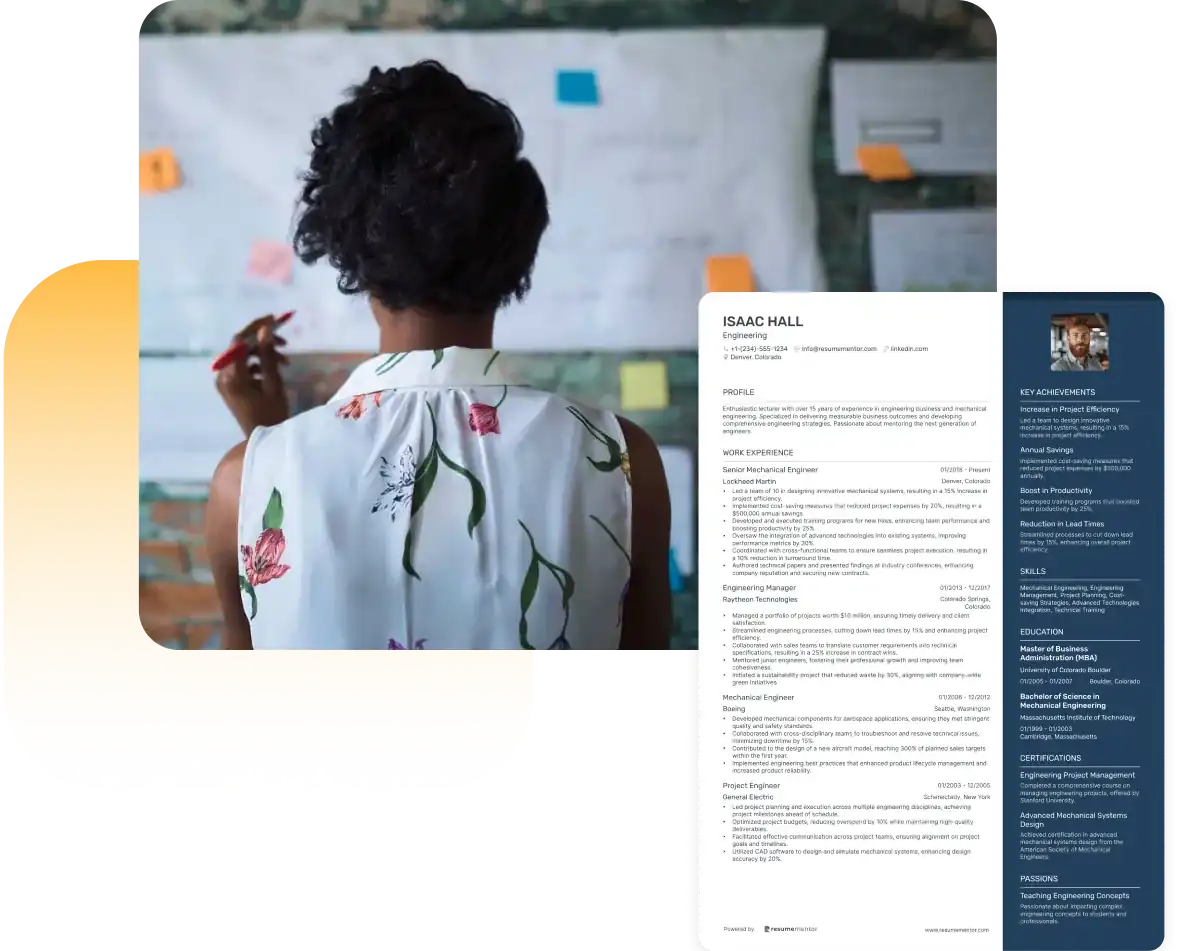
Continue Reading
Check more recommended readings to get the job of your dreams.
Resume
Resources
Tools
© 2025. All rights reserved.
Made with love by people who care.

